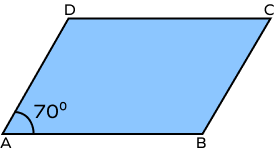What is Angles of a Parallelogram
A parallelogram has four interior angles that add up to $360^{\circ}$.
A parallelogram is a special type of quadrilateral that has both pairs of opposite sides parallel and equal. The given figure shows a parallelogram ABCD, which has AB II CD and AD II BC. Also, AD $=$ BC and AB $=$ CD.

Note that squares and rectangles are special types of parallelograms. In a rectangle, all angles are right angles. A square is both equilateral and equiangular.
Recommended Games
Angles of a Parallelogram
The sum of angles of a parallelogram is $360^{\circ}$. Opposite angles of a parallelogram are of equal measure. Consecutive angles of a parallelogram add up to $180^{\circ}$.
$\angle A = \angle C$ and $\angle B = \angle D$
$\angle A + \angle B + \angle C + \angle D = 360^{\circ}$

Recommended Worksheets
Properties of Angles of a Parallelogram
Here, we are going to study properties of angles of a parallelogram. Observe the following image to understand the important rules of parallelogram angles.

- In a parallelogram, opposite angles are congruent (equal). In the above image,
$\angle P = \angle R;\; \angle Q = \angle S$.
- All the angles in a parallelogram add up to $360^{\circ}$. Here,$\angle P + \angle Q + \angle R + \angle S = 360^{\circ}$.
- All the respective consecutive angles in a parallelogram are supplementary.
The supplementary angles in a parallelogram PQRS are as follows:
$\angle P + \angle Q = 180^{\circ}$;
$\angle Q + \angle R = 180^{\circ}$;
$\angle R + \angle S = 180^{\circ}$;
$\angle S + \angle P = 180^{\circ}$
Theorems Related to Angles of a Parallelogram
Let us learn about the theorems related to the angles of a parallelogram:
1. Opposite angles of a parallelogram are equal.
2. Parallelogram consecutive angles theorem: Consecutive angles of a parallelogram are supplementary.
Theorem 1: Opposite angles of a parallelogram are equal.
Given: PQRS is a parallelogram.
To prove: $\angle P = \angle R$ and $\angle Q = \angle S$

Proof: In the parallelogram PQRS, diagonal PR is dividing the parallelogram into two triangles.
Also, PQ || SR and QR || PS
Thus, the diagonal PR acts as a transversal.
On comparing triangles PQR and PSR, we have:
PR $=$ PR (common sides)
We know that alternate interior angles are equal.
Thus,
$\angle 1 = \angle 4$ (alternate interior angles)
$\angle 2 = \angle 3$ (alternate interior angles)
Thus, the two triangles are congruent, $\Delta\; PQR \cong \Delta\; PSR$
Therefore, $\angle Q = \angle S$ by CPCTC (corresponding parts of congruent triangles are congruent).
Similarly, we can show that $\angle P = \angle R$.
Opposite angles of a parallelogram are equal.
Hence proved.
Let’s prove the converse theorem as well.
The converse of the above theorem is as follows:
If the opposite angles of a quadrilateral are equal, then it is a parallelogram.
Given: $\angle P = \angle R$ and $\angle Q = \angle S$
To Prove: PQRS is a parallelogram.
Proof:
We know that the interior angles in a quadrilateral add up to $360^{\circ}$.
Therefore,
$\angle P + \angle Q + \angle R + \angle S = 360^{\circ}$
Now, we can substitute $\angle R$ with $\angle P$ and $\angle S$ with $\angle Q$ as it is given that
$\angle P = \angle R$ and $\angle Q = \angle S$
$= 2(\angle P + \angle Q) = 360^{\circ}$
$= \angle P + \angle Q = 180^{\circ}$.
This shows that the consecutive angles are supplementary.
It means that PS || QR.
Similarly, we can show that PQ || RS.
Hence, PS || QR, and PQ || RS.
PQRS is a parallelogram.
Hence proved.
Theorem 2: Consecutive angles of a parallelogram are supplementary.
Given: PQRS is a parallelogram, with four angles $\angle P \angle Q, \angle R, \angle S$ respectively.
To prove: $\angle P + \angle Q = 180^{\circ}, \angle R + \angle S = 180^{\circ}$.

Proof:
We know that PQ || RS
Consider PS to be a transversal cutting the parallel lines PQ and RS.
According to the property of transversal, we know that the interior angles on the same side of a transversal are supplementary.
Therefore, $\angle P + \angle S = 180^{\circ}$.
Similarly,
$\angle Q + \angle R = 180^{\circ}$
$\angle R + \angle S = 180^{\circ}$
$\angle P + \angle Q = 180^{\circ}$
Therefore, the sum of the respective two adjacent angles of a parallelogram is equal to $180^{\circ}$.
Thus, the consecutive angles of a parallelogram are supplementary.
Fun Facts!
- A parallelogram is a special type of quadrilateral that has both pairs of opposite sides parallel and equal.
- As opposite sides of a parallelogram are parallel, they will never intersect.
- Opposite angles of a parallelogram are equal.
- Interior angles of a parallelogram add up to $360^{\circ}$.
- Consecutive interior angles in a parallelogram (angles that are side by side) are supplementary, i.e., the total of it always equals to $180^{\circ}$
- The diagonal of a parallelogram separates it into two congruent triangles.
- Rectangles and squares are examples of parallelograms that have 90 degree angles, also known as right angles. Rhombuses and squares are examples of parallelograms that have sides of equal length.
- If one angle in a parallelogram is a right angle, then all angles are right angles.
Conclusion
A parallelogram is a special type of quadrilateral that has both pairs of opposite sides parallel and equal and opposite angles are congruent. Now that we have studied the theorems related to angles of parallelogram, let’s solve some examples for better understanding.
Solved Examples on Angles of a Parallelogram
1. In a parallelogram ABCD, if $\angle A = 60^{\circ}$, find the measure of $\angle D$ ?

Solution:
We know that,
Sum of consecutive (adjacent) angles of parallelogram is $180^{\circ}$.
$\angle A + \angle D = 180^{\circ}$
$60 + \angle D = 180^{\circ}$
$\angle D = 180^{\circ} \;-\; 60^{\circ}$
$\angle D = 120^{\circ}$
2. Two adjacent angles of a parallelogram are in the ratio 2:3. Find the measure of the angles.
Solution:
Let the angles be $2x$ and $3x$.
We know that the adjacent angles in a parallelogram are supplementary.
Thus,
$2x + 3x = 180$
$5x = 180$
$x =x 36$
Now, $2x = 2 \times 36 = 72$
and $3x = 3 \times 36 = 108$
Thus, the measure of the angles is $72^{\circ}$ and $108^{\circ}$.
3. In the given figure, ABCD is a parallelogram in which $\angle A = 70^{\circ}$. Find the measure of each of the angles.

Solution:
It is given that ABCD is a parallelogram in which $\angle A = 70^{\circ}$.
In a parallelogram, opposite angles are congruent.
Thus, $\angle C = 70^{\circ}$
Since the sum of any two adjacent angles of a parallelogram is 180°,
$\angle A + \angle B = 180^{\circ}$
$70^{\circ} + \angle B = 180^{\circ}$
$\angle B = (180^{\circ} \;-\; 70^{\circ}) = 110^{\circ}$
Angles B and D are opposite angles in a parallelogram.
$\angle D = \angle B = 110^{\circ}$
Therefore, $\angle B = 110^{\circ},\; \angle C = 70^{\circ}$ and $\angle D = 110^{\circ}$.
4. Two consecutive angles of a parallelogram are $(x + 60)^{\circ}$ and $(2x + 30)^{\circ}$. Find the measure of the two angles and write the type of parallelogram.
Solution:
We know that the consecutive interior angles of a parallelogram are supplementary.
$\therefore (x + 60)^{\circ} + (2x + 30)^{\circ} = 180^{\circ}$
$3x^{\circ} + 90^{\circ} = 180^{\circ}$
$3x^{\circ} = 180^{\circ} \;-\; 90^{\circ}$
$3x^{\circ} = 90^{\circ}$
$x^{\circ} = 30^{\circ}$
Thus, two consecutive angles are $(30 + 60)^{\circ} = 90^{\circ}$ and $2(30)^{\circ} + 30^{\circ} = 90^{\circ}$
We know that, if in a parallelogram one angle is 90 degrees, then all other angles are also 90 degrees.
Hence, the name of the given parallelogram is a rectangle with four right angles.
5. In the parallelogram ABCD given below, find $\angle A, \angle B, \angle C$, and $\angle D$.

Solution:
In a parallelogram, adjacent angles are supplementary.
In the above parallelogram, $\angle A$ and $\angle B$ are adjacent angles.
$x + 2x = 180^{\circ}$
$3x = 180^{\circ}$
$x = 60^{\circ}$
The measure of angle $\angle A$ is
$= x$
$= 60^{\circ}$
The measure of angle $\angle B$ is
$= 2x$
$= 2 \times 60^{\circ}$
$= 120^{\circ}$
According to the properties of parallelogram, the opposite angles are congruent.
$\angle C = \angle A$
Thus, $\angle C = 60^{\circ}$
Also, $\angle B = \angle D$
Thus, $\angle D = 120^{\circ}$
Hence, the measures of $\angle A, \angle B, \angle C$ and $\angle D$ are $60^{\circ},\; 120^{\circ},\; 60^{\circ}$ and $120^{\circ}$ respectively.
Practice Problems on Angles of a Parallelogram
Angles of Parallelogram – Definition, Properties, Theorems, Examples
In a parallelogram, the sum of the adjacent angles is ________.
All the respective consecutive angles or the adjacent angles in a parallelogram are supplementary, which means they add up to $180^\circ$.
In a parallelogram both pairs of opposite sides are ________.
A parallelogram is a special type of quadrilateral that has both pairs of opposite sides parallel and equal (congruent).
Which of the following statements is NOT TRUE ?
All the angles in a parallelogram add up to $360^\circ$.
In a parallelogram if one interior angle measures $50^\circ$, the opposite interior angle will measure ____ degrees.
In a parallelogram, opposite interior angles are congruent (equal). So if one interior angle measures $50^\circ$, the opposite interior angle will also measure $50\circ$.
What is the sum of angles of quadrilaterals?
Angles in a quadrilateral add up to $360^\circ$.
Frequently Asked Questions on Angles of a Parallelogram
What are the interior angles of a parallelogram?
Interior angles of a parallelogram are those that lie inside a parallelogram. They are formed by each pair of adjacent sides. The interior angles of a parallelogram sum up to $360^{\circ}$ and any two adjacent (consecutive) angles of a parallelogram are supplementary.
Are all parallelograms rectangles?
No, a parallelogram is not always a rectangle. In a rectangle, all angles must be equal to 90°. But for a parallelogram, interior angles need to be equal to 90°. However, all rectangles are parallelograms, because a rectangle has two sets of parallel sides and two pairs of opposite sides that are equal. Therefore, it abides by all the properties of a parallelogram.
Is parallelogram a quadrilateral?
Yes, a parallelogram is a quadrilateral. A quadrilateral is a closed shape and a type of polygon that has four sides, four vertices, and four angles. A parallelogram is also a closed figure with four angles. Hence, it can be called a quadrilateral.
Can a parallelogram have right angles?
Yes, a parallelogram with four right angles is known as a rectangle. In a rectangle, each pair of co-interior angles are supplementary, because two right angles add to a straight angle, so the opposite sides of a rectangle are parallel. This means that a rectangle is a parallelogram.
What is the difference between a parallelogram and rhombus?
The difference between a parallelogram and rhombus:
- A parallelogram is a quadrilateral that has opposite sides equal and parallel. A rhombus is a quadrilateral that has all its sides congruent.
- Diagonals of a parallelogram simply bisect each other while the diagonals of a rhombus bisect each other at $90^{\circ}$.
- In a parallelogram, opposite angles are of equal measure while, in a rhombus, all four angles are of equal measure.





























